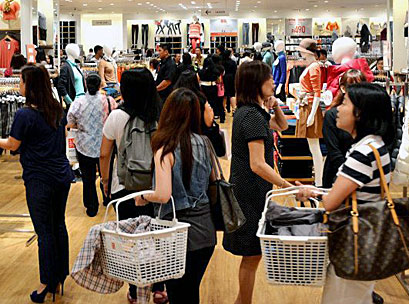Living in the Philippines requires patience and this is never more evident than when shopping.
When it comes to customer service in the Philippines, you are more likely to be disappointed, frustrated and angered than you are to leave the store a happy shopper. It is easy to believe many retailers in the Philippines have an attitude of “the customer comes last”!
Every day we shop we conclude that retailers just do not understand the importance and value, (can be measured in sales, profit and customer loyalty), of “the customer comes first” attitude!
I have concluded that because a few players have a monopoly on most market segments they find it relatively easy to bank big profits year after year and this has them believing themselves to be good retailers; even if they are they should want to be even better.
I dare say some retailers reading this article will dispute these comments and I concede there are some who get customer service right. They are living proof that quality customer service can be achieved. However, these businesses are the exception, not the rule.
Why do customers allow retailers to get away with poor customer service? The answers could be:
1. Filipinos by nature do not like public confrontation so often they will simply accept poor customer service and leave the store in silence.
2. Tradition, habit and lack of exposure to “world’s best” service standards possibly means shoppers believe the customer service experienced is actually acceptable.
3. Because of traffic problems and lack of disposable income Filipinos do not travel too far from home. This results in shoppers tolerating poor customer service at stores in the nearest mall location.
The following examples support my theory that too many retailers have an attitude of “the customer comes last”. I have listed just a few examples from a single day shopping in leading stores in one of the nation’s premier malls.
Planograms and store layouts: These disciplines are designed to maximize ease of product location for the shopper, imperative in a self-serve retail environment.
We had a frustrating shopping experience in a supermarket which, in the lead up to the busiest time of the year, completed significant relays (changing the sequence and positioning of product categories). The consequence for the shopper, who just wanted to fill their trolleys, pay at the checkouts and get out of the store within the shortest timeframe, was frustration, confusion and wasted time looping around the aisles in search of the wanted items that were no longer in the usual store location.
Looking to buy a new broom, we found them, (by accident) in three different locations in the Hardware section. Whilst this can be the result of Planograms being created with a lack of process skill, in this instance it was clearly the result of allocating space by consignment supplier.
Stock availability – most retailers understand you cannot sell what you do not have and yet a daily experience in retail stores in the Philippines is for the service assistant to announce “wala” which loosely translated means ‘does not exist’.
In retail terms this simply means “out of stock”. We faced this problem when trying to purchase a specific shirt size. The assistant suggested we buy the smaller size because it was available and that was despite the fact I could hardly button it up without risking strangulation. I asked “do you have a larger size?” and again the response was “wala”.
Past experience and simple observations identifies the main reasons for out of stocks are poor item quantification, inadequate order lead times or unacceptable late deliveries by suppliers. The biggest problem of all occurs when the retailer abdicates retail stock control and places their destiny in the hands of Consignment Suppliers.
Price tickets – in a self-serve supermarket environment a customer needs to identify price accurately and quickly. When trying to buy a tooth brush in our supermarket we were faced with a display of 80 hooks and not a single peg carried a price sticker. Above the toothbrush display was a mass of 72 price stickers. Price points ranged from P57 up to P276. Item descriptions on the price stickers were abbreviations and could not be matched to actual products on the hooks making it impossible to determine the price of any individual toothbrush. We didn’t buy a toothbrush!
How can it be that a large and reputable supermarket fails to understand the basic rules for pricing in a self-serve environment? Are there no display standards or is it an issue of failure to implement the standards? Is there a budget constraint on purchasing the correct display equipment? Whatever the answer – make that excuse – it is a failure to understand the needs of the customer.
Product knowledge – with some products there is a need to receive product knowledge as an important step in the purchase process. Wanting to buy a large screen TV in a leading appliance specialist store, we were totally confused by the number of price options on the same size screen within the same brand. We asked an assistant for help and his advice was to point out the different prices and the different bonus offers; he failed to explain the technical specifications for each item! We left the store without purchasing a television.
How can a service assistant not have product knowledge skills? In part the answer is because the priority in consignment is to sell fast to earn commission. It is also likely the consignment supplier is not willing to invest in training as they too are simply interested in sales achieved. The retailer is satisfied with consignment rental and has limited customer interface leaving customer service standards in the hands of the consignment supplier.
In all of these examples there are the same two horrific outcomes for the retailer:
* Customers spend less money in stores who do not understand and adopt “the customer comes first” ethic and the result is lost sales, profit and decreased market-share!
* Customers can be driven to spend in a competitor’s store where they do practice “the customer comes first” disciplines and this will result in lost customer loyalty!
The lesson here should be clear. If you do not understand your customer and if you do not have an attitude of “the customer comes first” then be prepared because with increasing competition, new retail channels and smarter customers you will end up in the trap where the customer decides “the retailer comes last”.
InsideRetail.Asia columnist Darrell Wisbey has 30 years retail experience, living and working in Australia and Asia. He is based in the Philippines and a member of Impact Retailing. Email Darrell.






